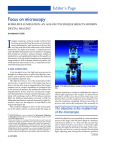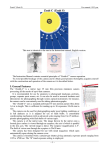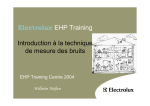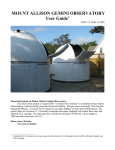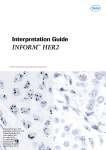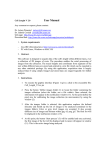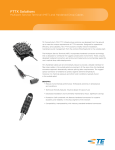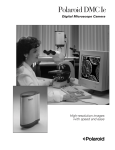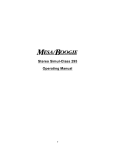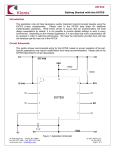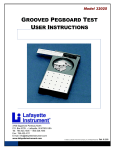Download article - Microscopy/Microscopy Education
Transcript
Editor’s Page Focus on microscopy KOEHLER ILLUMINATION: AN AGE-OLD TECHNIQUE IMPACTS MODERN DIGITAL IMAGING BY BARBARA FOSTER I magine running a clinical sample without first learning and perfecting the protocol. Ironically, many pathologists a and clinicians fall into that very trap with one of the oldest tools in the clinical l a b o r a t o r y : the light microscope. A simple pro c e s s called Koehler illumination sets a baseline for imaging that minimizes artifacts, reduces fatigue, enhances productivity, and significantly improves the quality of information fed into digital imaging and automated image analyses. With a modest amount of practice, the whole process takes under 45 sec, a small time investment that reaps great rewards. a b c d f e A quick anatomy lesson In its simplest form, the light microscope can be thought of as three pieces of glass (the objective, condenser, and eyepieces) and two controls (the field iris and condenser aperture iris). The objective (Figure 1c) is the mastermind of the m i c roscope. A quick review of its engraving shows that it sets the first step of magnification (the largest number) and is a major contributor to resolution (set by the numerical aperture, the number that follows the magnification). It may also have an internal component that generates a special contrast technique, annotated with markings such as PH for phase contrast, HMC for Hoffman modulation contrast, or DIC for differential interference contrast (frequently called Nomarksib). Focus for the objective is controlled by the large knob (Figure 1h). The condenser (Figure 1d and e) is the second partner in the optics scheme. Located under the stage, its a interpupillary adjustment b eyepiece and diopter adjustment c objectives d condenser aperture control e condenser focus f`condenser centration screw g fine focus h coarse focus i light port/field iris adjustment g i h Figure 1 The light microscope. (Image courtesy of Carl Zeiss, Inc.) aperture (opening or window) establishes the angle at which light approaches the sample. To demonstrate this effect, use the coarse focus to lower the stage comp l e t e l y, then use the condenser focus (Figure 1e) to raise the condenser completely. Remove one of the objectives and rotate the nosepiece (the assembly in The objective is the mastermind of the microscope. a A recent proprietary survey conducted by Microscopy/Marketing & Education indicates that over 75% of pathologists rarely or never set Koehler illumination. b In the mid 1960s, Dr. Georges Nomarski discovered a special method for cutting the prisms that are central to many DIC systems and that made the technique commercially viable. His approach is widely used by Carl Zeiss, Inc. (Thornwood, NY). However, other companies may use other designs to achieve the same goal. Leica (Bannockburn, IL),for example, uses a system designed by Francis Smith. Despite these differences, “Nomarski” has been adopted as a generic name, just as Kleenex is often used to refer to facial tissues. 8 JULY 2002 which the objectives are mounted) to create maximum access to the stage. Fold the lower third of a business card back to make an “L,” then rest the card on that short, folded section, just above where the light emerges through the opening in the stage. When in position, the card acts as a screen to capture the emerging light. Opening and closing the condenser aperture continued EDITOR’S PAGE continued or darkfield (D). Eyepieces (Figure 1b) complete the trio. They are responsible for the second step of magnification (again, the larger engraved number) and for setting the diameter of the field of view (the field number, seen as the second engraved value, given in millimeters). To determine the maximum diameter of the field seen with any particular objective, simply multiply the field number by 1000 to convert to micrometers, then divide by just the magnification of the objective. For example, if an eyepiece bears a field number of 25 mm and you are using a 10× objective: 25,000 divided by 10 equals a field diameter of 2500 µm. This information is valuable for estimating the size of features in the field. For instance, if you estimate that 20 cells would fit across the diameter of your scene, divide 2500 µm by 20, indicating that each cell is 125 µm wide. The last control is the field iris, located in the light port in the base of the microscope (i). This control adjusts the size of the field of view and controls glare and haze. If the sample scatters light, creating a milky image, simply move the feature of interest to the center of the field of view and close the field iris around it. (This step assumes that the microscope has been set up for Koehler illumination.) a b Figure 2 Cheek cells imaged with a) normal brightfield, and b) axial illumination (40×). control (Figure 1d) opens and closes a “cone” of light. When closed, the beam forms a pencil of light (axial illumination) with little or no angle. Axial illumination enhances edges (compare Figure 2ato 2b) and increases the depth of field, making it the logical choice for imaging thicker samples. Opening the condenser maximizes the angle and produces a narrow “waist” at the sample. Providing that the specimen is well stained, this setting is optimum for imaging fine structures such as the endoplasmic reticulum or tiny particles such as those in granulocytes. The condenser aperture control (d) is the most powerful control on the microscope and the most often overlooked. Judicious use of this setting significantly improves the quality of images. The condenser may also contribute to contrast enhancement. Universal condensers, for example, have either sliders or rotating turrets with multiple locations for inserts for techniques such as phase contrast (typically noted with regular numbers such as 1, 2, or 3, which correspond to markings on the objective), HMC, DIC (typically marked with Roman numerals), 10 JULY 2002 Koehler illumination in detail Directions for setting up Koehler are as diverse as recipes for Mulligan stew. The instructions shown here simplify the process, making it easy to incorporate Koehler into the every-day work flow. They center on two key issues: a) The sample determines the setting, and b) the microscope has three pieces of glassware and two controls. This discussion starts with the details then summarizes the process in four quick and easy steps. Before we begin, make sure that the rheostat that controls the brightness of the light is set so that the field of view is comfortably bright and not yellow. Your user’s manual will tell you which voltage is optimum. Eyepieces Start by setting the binoculars to the right distancec so that you see one, round field of view. Most microscopes have a small scale [a] so that you can reset to this same distance every time you sit down at a new microscope. Check to see if the eyepieces have focusing rings c The interpupillary distance (IPD) is, literally, the distance in millimeters from pupil center to pupil center when you are looking straight ahead. EDITOR’S PAGE continued a b c d Figure 3 Field iris closed. a) Condenser uncentered and unfocused, b) condenser focused on field iris, c) condenser centered and fo cused, d) field iris opened outside the field of view. EDITOR’S PAGE continued (diopter settings [b]). If so, set them both to zero or, if there are no numbers, so that the silver, white, or black ring just touches the eyepiece mount. Objective Using the nosepiece, rotate the 10× objective into place. Put a sample on the stage. Make sure that if there is a coverslip (a small piece of glass on the specimen) the sample is mounted with the coverslip toward the objective. While observing the distance between the objective and sample from outside the microscope, use the coarse focus (h) to carefully move the stage toward the objective. Note which direction you are turning the knob. Stop when the sample is as close as possible to the objective, then, while observing the sample through the eyepieces, focus away. That is, turn the coarse focus the other direction until the specimen comes into sharp focus. This procedure not only avoids damage to slide and objective, it also guarantees that you will always find the specimen quickly, an important productivity step. Condenser This step encompasses four smaller steps: focusing and centering the condenser, then setting both the condenser aperture and field irises. Using the condenser focus control (the small knob under the stage, [e]), raise the condenser to the back of the slide. Again, note which direction you are turning the knob. While the objective uses the sample as a reference for focus, the condenser uses the field iris (i) as reference. Close the field iris (Figure 3a). Using the condenser focus, focus away until the edges of the field iris come into sharp focus (Figure 3b). Notice that the image of the field iris is off-center at this point. Locate the condenser centration scre w s ( F i g u re 1f). Ty p i c a l l y, they are mounted at 5 and 7 o’clock. While peering through the microscope, use the s c rews to “walk” the image of the field iris into the center of the field of view (Figure 3c). At first, this p rocess will seem awkward because these scre w s work against each other and along the diagonals rather than left and right, up and down. Microscopy involves strong eye–hand–brain coordination and this situation is one of those cases in which a little practice will improve that coordination considerably. Unless the sample is highly scattering, open the field iris (i) so that it is just outside the field of view (Figure 3d). Adjust the condenser aperture iris (d) so that the edges of the features are crisp and the background is clean. If the condenser is set too far open, the image will appear washed out. If it is too far closed, the edges will be too thick and there will be rings 12 JULY 2002 EDITOR’S PAGE continued around every little bit of dust and dirt. Eyepieces revisited Each of us has a dominant eye.d It is the eye that guides us as we walk around the world and that we use when aiming in contests such as darts, archery, or shooting. If both eyepieces are focusable, leave the diopter setting for your dominant eye at zero. Focus the eyepiece for the nondominant eye so that you see the specimen in the field of view clearly. This small adjustment compensates for each eye’s unique focus and avoids the terrible headaches and eyestrain often experienced by people who use microscopes for a living. Four quick steps and 45 seconds to perfection Practice makes perfect. By the time you have practiced these steps four or five times, you should be able to establish Koehler illumination in well under 45 sec. 1. Eyepieces.Set IPD for one, round field of view and diopter settings to “0.” 2. Objective.Raise stage until nearly touching the sample (view from outside), then focus away (view through microscope) until the image of the sample is sharp. 3. C o n d e n s e.r Raise condenser so that it bare l y touches the back of the sample (view from outside). Close the field iris (view through microscope), then focus away until edge of field iris is sharp. Center condenser. Open the field iris just outside of the field of view and set the condenser aperture iris for sharp edges and clean background. 4. Eyepieces.Adjust diopter setting for nondominant eye until image seen with that eye is sharp. A few final tips Koehler illumination forms the baseline for all mic roscopy imaging. Set it first thing in the morning, then fine-tune it whenever you change objective or sample. These few swift adjustments are guaranteed to p roduce better photomicrographs and significantly improve information for automated imaging systems. One final note: Unlike any other analytical technology, microscopists are part of the microscope system. Establishing Koehler is also guaranteed to reduce neck and eye strain and improve your productivity at the microscope. d To find your dominant eye, make a triangular window by touching your two index fingers together and your two thumbs. Hold the window at arm’s length and use it to locate a distant object. Look at the object with both eyes, then close your right eye. If the object stays in place or only moves slightly, you are left-eye dominant. If it moves dramatically (for example, out of the window), you are right-eye dominant. Ms. Foster is President of Microscopy/Microscopy Education, 125 Paridon St., Ste. 102, Springfield, MA 01118, U.S.A.; tel .: 413-746-6931; fax: 413-746-9311; e-mail: [email protected]. She encourages comments and inquiries about the new technologies presented in her articles. AMERICAN CLINICAL LABORATORY 13





